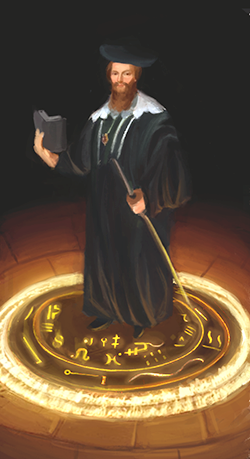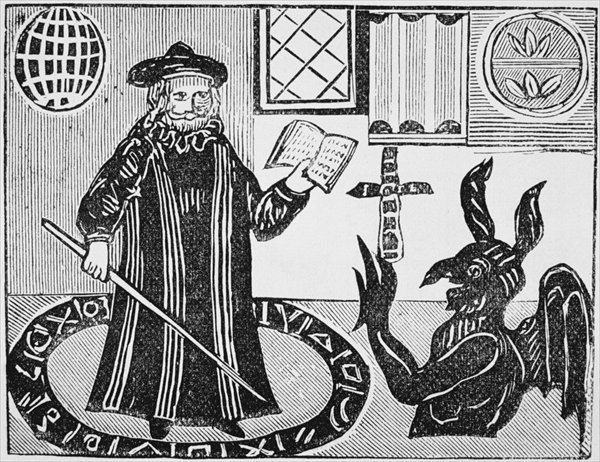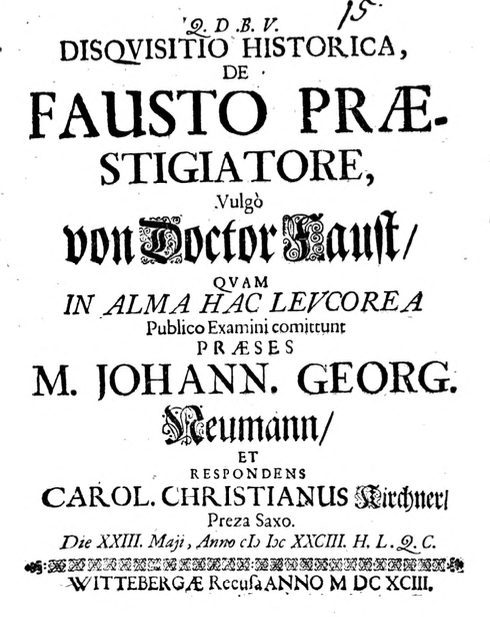Johann Georg Faust

Johann Georg Faust (c. 1480 or 1466 – c. 1541), also known in English as John Faustus, was a German itinerant alchemist, astrologer, and magician of the German Renaissance.
Doctor Faust became the subject of folk legend in the decades after his death, transmitted in chapbooks beginning in the 1580s, and was notably adapted by Christopher Marlowe as a tragic hero in his play The Tragical History of the Life and Death of Doctor Faustus (1604).
Biography
Because of his early treatment as a figure in legend and literature, it is difficult to establish historical facts about his life with any certainty. In the 17th century, it was even doubted that there ever had been a historical Faust, and the legendary character was identified with a printer of Mainz called Johann Fust. Johann Georg Neumann in 1683 addressed the question in his Disquisitio historica de Fausto praestigiatore, establishing Faust's historical existence based on contemporary references.
Possible places of origin of the historical Johann Faust are Knittlingen, Helmstadt near Heidelberg, or Roda. Knittlingen today has an archive and a museum dedicated to Faust.
Faust's year of birth is given either as 1480/1 or as 1466. The city archive of Ingolstadt has a letter dated 27 June 1528 which mentions a Doctor Jörg Faustus von Haidlberg. Other sources have Georgius Faustus Helmstet. In the archives of Heidelberg University, there are records of a Georgius Helmstetter inscribed from 1483 to 1487, stating that he was promoted to baccalaureus on 12 July 1484 and to magister artium on 1 March 1487.
Wandering magician
For the year 1506, there is a record of Faust appearing as performer of magical tricks and horoscopes in Gelnhausen. Over the following 30 years, there are numerous similar records spread over southern Germany. Faust appeared as physician, doctor of philosophy, alchemist, magician and astrologer, and was often accused as a fraud. The Catholic Church denounced him as a blasphemer in league with the Devil. Faust was also accused of being a Protestant Christian.
Johannes Trithemius in a letter to Johannes Virdung dated 20 August 1507 warns the latter of a certain Georgius Sabellicus, a trickster and fraud styling himself Georgius Sabellicus, Faustus junior, fons necromanticorum, astrologus, magus secundus etc. According to Trithemius, in Gelnhausen and Würzburg, Sabellicus boasted blasphemously of his powers, even claiming that he could easily reproduce all the miracles of Jesus Christ. Trithemius alleges that Sabellicus received a teaching position in Sickingen in 1507, which he abused by indulging in sodomy with his male students, evading punishment by a timely escape.
Conrad Mutianus Rufus in 1513 recounts a meeting with a chiromanticus called Georgius Faustus, Helmitheus Heidelbergensis (likely for hemitheus, "demigod of Heidelberg"), overhearing his vain and foolish boasts in an Erfurt inn.
On 23 February 1520, Faust was in Bamberg, doing a horoscope for the bishop and the town, for which he received the sum of 10 gulden.
In 1528, Faust visited Ingolstadt, whence he was banished shortly after. In 1532 he seems to have tried to enter Nürnberg, according to an unflattering note made by the junior mayor of the city to "deny free passage to the great nigromancer and sodomite Doctor Faustus." Later records give a more positive verdict; thus the Tübingen professor Joachim Camerarius in 1536 recognises Faust as a respectable astrologer, and physician Philipp Begardi of Worms in 1539 praises his medical knowledge. The last direct attestation of Faust dates to 25 June 1535, when his presence was recorded in Münster during the Anabaptist rebellion.
Death
Faust's death is dated to 1540 or 1541. He allegedly died in an explosion of an alchemical experiment in the "Hotel zum Löwen" in Staufen im Breisgau. His body is reported to have been found in a "grievously mutilated" state which was interpreted to the effect that the devil had come to collect him in person by his clerical and scholarly enemies.
In 1548, the theologian Johann Gast in his sermones conviviales states that Faust had suffered a dreadful death, and would keep turning his face to the earth in spite of the body being turned on its back several times. In his 1548 account, Gast also mentions a personal meeting with Faust in Basel during which Faust provided the cook with poultry of a strange kind. According to Gast, Faust travelled with a dog and a horse, and there were rumours that the dog would sometimes transform into a servant.
Contemporary reputation
Posthumous accounts concerning the life of Doctor Faustus by his contemporaries were extensive.
Johannes Manlius, drawing on notes by Melanchthon, in his Locorum communium collectanea dating to 1562. According to Manlius, Johannes Faustus was a personal acquaintance of Melanchthon's and had studied in Kraków. Manlius' account is already suffused with legendary elements, and cannot be taken at face value as a historical source. Manlius recounts that Faust had boasted that the victories of the German emperor in Italy were due to his magical intervention. In Venice, he allegedly attempted to fly, but was thrown to the ground by the Devil.
Johann Weyer in De praestigiis daemonum (1568) recounts that Faustus had been arrested in Batenburg because he had recommended that the local chaplain called Dorstenius should use arsenic to get rid of his stubble. Dorstenius smeared his face with the poison, upon which he lost not only his beard but also much of his skin, an anecdote Wier says he heard from the victim himself.
Philipp Camerarius in 1602 still claims to have heard tales of Faust directly from people who had met him in person, but from the publication of the 1587 Faustbuch, it becomes impossible to separate historical anecdotes from rumour and legend.
The town of Bad Kreuznach has a "Faust Haus" restaurant reportedly built in 1492 on the site of "the home of the legendary Magister Johann Georg Sabellicus Faust."
Authorship of grimoires
There are several prints of grimoires or magical texts attributed to Faust. Some of them are artificially dated to his lifetime, but the prints in fact date to the late 16th century, from ca. 1580, i.e. the same period of the development of the Volksbuch tradition. Variants of the Höllenzwang attributed to Faust continued to be published for the next 200 years, well into the 18th century.
It became fashionable for occultists in central Europe to list Faust as the author of their texts to protect themselves from the wrath of the Church under charges of heresy. This practice was common throughout the Medieval world, and mimics the ancient authors who remained anonymous by listing King Solomon or Hermes Trismegistus as the author of their text.
Legendary Faust
The Historia von D. Johann Fausten printed by Johann Spies 1587, a German chapbook about Faust's sins, began the literary tradition of the Faust character. It was edited and excerpted by G. R. Widmann and Nikolaus Pfitzer, and was finally re-published anonymously in modernised form in the early 18th century, as the Faustbuch des Christlich Meynenden. This edition became widely known and was also read by Goethe in his youth. As summarized by Richard Stecher, this version is the account of a young man called Johann Faust, son of a peasant, who studies theology in Wittenberg, besides medicine, astrology and "other magical arts." His boundless desire for knowledge leads him to conjure the Devil in a wood near Wittenberg, who appears in the shape of a greyfriar who calls himself Mephistopheles.
Faust enters a pact with the Devil, pledging his soul in exchange for 24 years of service. The Devil produces a famulus Christoph Wagner and a poodle Prästigiar familiar to accompany Faust in his adventure. Faust goes on to live a life of pleasures. He visits the Pope in Rome, the Sultan in Constantinople and the Kaiser in Innsbruck. After 16 years, he begins to regret his pact and wants to withdraw, but the Devil persuades him to renew it, conjuring up Helen of Troy, with whom Faust sires a son called Justus. As the 24 years come to an end, "Satan, chief of devils" appears and announces Faust's death for the coming night. Faust at a "last supper" scene in Rimlich takes leave of his friends and admonishes them to repentance and piety. At midnight, there is a great noise from Faust's room, and in the morning, its walls and floors are found splattered with blood and brains, with Faust's eyes lying on the floor and his dead body in the courtyard.
The most famous depiction of Faust was in Christopher Marlowe's 1592 play The Tragical History of the Life and Death of Doctor Faustus. When it premiered in London, it was a smash hit, using rudimentary special effects to make spirits and demons appear on stage. Contemporary accounts stated the play drove spectators mad through the conjuration of real ghosts during the performance. Marlowe's Doctor Faustus remains a controversial play more than 400 years after its publication due to its ritual invocation of the Devil and challenges to religious doctrine.

